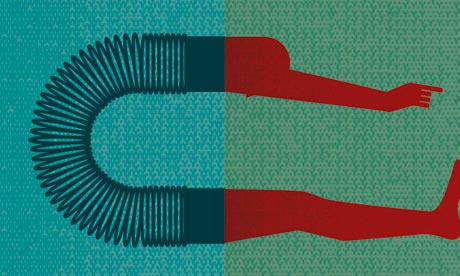
At the heart of your new workout are the five elements of physical fitness – an all-round fitness that you can apply to daily activity. While some elements are widely talked about, others are often ignored, and that's one of the reasons this workout is so different. Rather than focusing on just the most common aspects of fitness, it brings together the key ingredients of flexibility, stability, strength, cardio and power, to ensure that you get a balanced, functional and effective workout – and achieve the most sustainable and satisfying results.
Flexibility
Even if you can't touch your toes, you can still train your body to become more flexible. Stretching out the muscles before exercise helps ease muscle tension and joint pain, and warms the muscles so each exercise can be done safely through a full range of movement. The safest and most effective to begin with is a static stretch, performed slowly, within your own capability. Stretching is just as important at the end of a workout to avoid muscle tension later on. Exhale and ease into each stretch – you will find you can stretch further.
Stability
People usually associate stability with their core, but it's just as important to strengthen the stability of the joints in the body. This allows strong, fluid movements, with fewer injuries. But your core – the area of the body connected to the abdominals, pelvis, lower back and diaphragm – is important. Training this area can improve posture, increase energy levels and reduce the risk of injury. Effective stability training is dependent on a focused and concentrated mind, which will ensure a full range of motion, good balance and correct form.
Strength
Strength is not simply muscle size – it is the amount of force a muscle can generate at a specific velocity. For men, strength exercises will add size to the muscles, but for women, who have less testosterone, it will simply create a more athletic-looking body. Strength training also increases fuel-storage capacity in the muscles, improving everyday endurance. Studies have shown that it also fine-tunes the nervous system. Form is the key issue to focus on in strength training, ensuring the movement is smooth, steady and effective.
Cardio
One of the many roles of the cardiovascular system is to transfer oxygen and other nutrients to our muscles. Cardio exercise usually refers to aerobic activity, such as running and swimming, but any exercise that significantly raises your heart rate and keeps it there could be described as cardio. Over time this kind of exercise increases the size of the heart muscle, meaning blood and oxygen can be pumped more efficiently. As you get fitter, your heartbeat gets stronger, and your lungs have to work less hard. Recovery is key for this element of fitness.
Power
Power is the ability of a muscle to maximally contract in an instant to create explosive movement. Think of a sprinter coming out of the blocks or a gymnast leaping into the air. This natural "springiness" is both genetic and conditioned: some people are born with more so-called "slow-twitch" muscles (making them good endurance athletes); others have more "fast-twitch" fibres (better at short bursts of speed or force). But power can be developed. By focusing on timing and rhythm you may uncover a natural gift for flying high or jumping long.
Ten tips to take away
1 Stretch regularly Take time to stretch first thing in the morning and last thing at night. It will improve your flexibility and make you feel more relaxed.
2 Commute the healthy way Whenever possible, try to walk, jog or cycle to work, rather than drive or take public transport. If you live too far away, consider parking further from work, or getting off the bus or train a few stops earlier.
3 Use the stairs If there is a choice between the stairs and the lift, always go for the stairs. This is such an easy way to improve your fitness. And try to walk up and down escalators, too.
4 Take a break If you have a sedentary job, take regular breaks to stretch and keep the body moving. Get some fresh air at least a couple of times a day, and walk a bit further to get your lunch.
5 Play with the kids Take time to be active with your children and you will be carried along by their natural energy and enthusiasm. You won't even notice that you're raising your heartbeat and working your muscles.
6 Find fit friends The more time you spend with like-minded people who enjoy an active lifestyle, the more chance you'll join in. It doesn't mean giving up your old friends, but simply adding some new ones.
7 Don't be shy As we get older and less active we tend to lose confidence in our physical ability. So do more! Dig out the sports equipment, fix your old bike and make use of the facilities in your neighbourhood to get fit faster.
8 Track your activity When you keep a journal or log of your physical activity you are likely to do more. So get yourself a diary and make a note of all you're doing to get yourself fit.
9 Be inventive When you injure yourself it can be tempting to throw in the towel and stop exercising completely. But be creative and try to find an exercise that can accommodate the injury.
10 Watch what you eat The food you choose to eat will inevitably affect your fitness. You don't need to become a calorie counter, but think less chocolate cake and more green vegetables.
• Andy Puddicombe is a co-founder of Headspace

